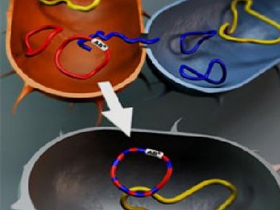Bacteria contain a small DNA molecule known as a plasmid in addition to the main DNA strands, or chromosomes. A plasmid is a small DNA ring found outside the chromosomes in many species of bacteria. A rounded DNA molecule of no fundamental importance to the bacterium, a plasmid-according to evolutionists-provides selective benefits. This plasmid DNA's round shape enables it to enter or leave the bacterium with ease. This feature of plasmids led to DNA combination research.
Plasmid transfer is one of the techniques that scientists discovered for the purpose of combining DNA. Research into newly combined (recombinant) DNA is performed by combining the DNAs of different organisms to obtain large enough quantities of specific genes to be able to study them. Many biologists regard this method as one of the most valuable means of biological research yet discovered.185
One of the discoveries revealed by this technique is bacteria's antibiotic resistance. The genes of bacteria that have proved resistant in the past are transmitted to other bacteria by way of plasmids. Resistant genes are generally found in plasmids. In this way, a resistant gene acquired by a non-resistant bacterium can easily be added onto its own DNA. This means that from a single resistant bacterium, a resistant bacterial colony can emerge in a very short time.
However, nothing about this mechanism provides evidence for evolution, because the genes that endow resistance in bacteria are not formed as the result of mutations. All that occurs is the transmission of genes already existing among bacteria.
185. Mahlon B. Hoagland, Hayatın Kökleri ("The Roots of Life"), pp.78-79.


